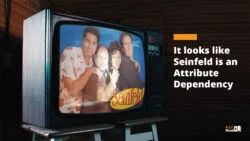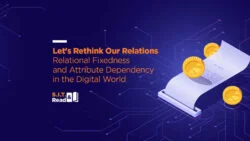Reruns of “Seinfeld” on Netflix are a glimpse into a 30-year-old time capsule that allows one to dig up innovative ideas that, for some reason, have never been implemented. One of the hidden potential startups is Elaine’s brilliant suggestion, when Jerry, George and she impatiently wait in line at a Chinese restaurant:
“You know, it’s not fair that people are seated first come – first serve. It should be based on who’s hungriest”
Credit: Seinfeld on Twitter
Silly idea? Or wonderful? It probably depends on whether you are hungry when you first hear it. One thing is sure, though – it is too seldom that one rethinks the nature of the connection between the various components of a system, product, or service, and thus, many an opportunity for real innovation is forever lost.
Imagine an external training program offered by your company to a limited number of employees. Since it is too expensive to send everyone who wishes to go, the company selects based on professional knowledge or experience.
At first thought this sounds like a logical and proper consideration, which ensures that the level of trainees is uniform, and participants can process new material based on their knowledge and experience.
But one can look at this situation from another angle. Those selected for training will probably be employees who already master the field, while employees with no background (but with high potential) will have a slim chance of joining. Paradoxically, this means that the cumulative value that the company’s employees have gained from this external training is lower than that of a similar training with participants with no previous knowledge.
The decision to use prior knowledge as a selection criterion for the training is an example of Relational Fixedness, one of the barriers that can interfere with innovation processes.
Relational Fixedness is the tendency to perceive connections and dependencies between variables of a system in one certain way, without being able to imagine different relations.
All types of fixedness are cognitive mechanisms that enable quick understanding of objects and situations, allowing us to take immediate action. Such mechanisms are beneficial and even crucial at both the personal and organizational levels. At the same time, they can be a significant barrier to innovation, as they make it difficult for us to identify new opportunities.
There are other ways to connect the dots
What does it mean to consider different relations between the variables of a system’s components? Let’s look at one of the important variables in any business: the price of the product.
Seemingly, there should be no connection between the price of a consumer product, such as a pair of glasses, and the characteristics of other parameters of the business, such as the location of the store or the day of the year. In practice, many business models display different pricing for the same product depending on these exact characteristics, as evidenced in holiday discounts or outlet stores. These models are examples of breaking Relational Fixedness.

And what do you think about this campaign by a major optical retailer in Israel? The number of percentage points discounted from a customer’s price is exactly the age of that customer. If the customer is 62 years old, he or she will receive a 62% discount.
But how do you produce such unconventional ideas, and how do you make sure they are more than a gimmick? We believe that the way to do this is through systematic thinking and the use of thinking tools that force the would-be innovator to perceive the components that are already available, but through a different lens.
The thinking tool that can lead to the generation of, for example, an age-dependent discount is called in SIT “Attribute Dependency”. The process of using this tool consists of listing the components of the product or system, specifying their characteristics, and then modifying the existing relations (or dependencies) between those characteristics (or creating new ones if none exist).
In the next section we will explain and demonstrate how this can be applied in the context of digital and data-based products.
Relational Fixedness in a data-driven world
What about the digital data-laden world we live in today – is Relational Fixedness prevalent there, as in the world of tangible products? Definitely!
Fixedness is not a feature of computers or databases, but a characteristic of human thinking, including those humans who make the design, marketing, and operational decisions in cutting-edge technology companies.
The information available thanks to digital tools can point to surprising new opportunities, which can easily be missed because they seem “illogical” or because fixedness prevents one from noticing them in the first place.
Despite the fixedness, the abundance of data that can be monitored, processed, and presented to customers has in recent years led to a wealth of new and fascinating models, and to the creation of connections that did not exist in the past between variables of product components.
Here are three reasons why companies choose to break Relational Fixedness in their digital products and offerings, and a few examples for each reason:
I. Make the most of the value embodied in the technology.
- In most smartphones, “low battery” mode automatically turns on when the battery runs low. In such cases, display will be dimmed, since screen brightness is a big battery drain. In Attribute Dependency lingo, a new connection has been created between the energy level of the battery and the level of illumination of the screen.
- Many digital services and apps are affected by the speed of the internet connection. App providers often operate multiple data centers around the world, and use smart traffic routing to the nearest one, according to user’s IP addresses. The location of the server from which the users receive service depends on the location of the users themselves, a dependency that was not possible in the past.
II. Improve conversion rates and sales
- Determining users’ location is beneficial not only to improve the service they get, but also to maximize the probability that they purchase additional products. Location-based services (based on cellular data, WiFi, etc.) demonstrate sophisticated relations between users’ whereabouts and advertising content presented to them.
- The scope and resolution of data held by digital stores allow for dynamic pricing strategies, based on a huge number of variables. Some companies even choose to implement differential pricing of the same product, based on the type of cellphone used while shopping online.
III. Design considerations and improving the user experience
- The abundance of accessible data and variables for each product and customer makes it possible to fine-tune the users’ experience. Why should all Waze users be represented by the same avatar, when new users can appear, say, as baby-Wazers, and “senior” users as grown-ups? Why should the Google logo always look the same, when it can vary on different days of the year or appear differently in each country?
- To ensure a fast and smooth onboarding process, many applications offer an increasing number of features as the user’s level rises. New users will be offered a limited set of capabilities, and as they continue to gain experience, additional features will be revealed to them. A gradual onboarding prevents unnecessary confusion and allows for effective learning of each feature.
It can be clearly seen that data-driven companies know how to make good use of valuable information to create new connections between variables of the application or product components. In fact, we have become accustomed to smarter and more personalized applications, making the most of every characteristic of users’ behavior, their surroundings and even the application mode itself.
How to leverage what we have learned from these examples
How can such new proposals be systematically generated? And how can one change or unlink existing dependencies, in a way that is not intended to meet a particular need, but to open new horizons for surprising opportunities?
Applying the “Attribute Dependency” thinking tool can be just the answer. In addition to conventional thinking, which emerges from analyzing needs, this tool makes it possible to systematically explore additional possibilities. Here are the operating instructions for a simple version of the tool:
1. Prepare a list of variables:
- 5-8 internal variables of the product you are working on (internal variables, i.e., those that the manufacturer has control over: volume, screen size, price of the product or service, color…).
- 5-8 variables in the product’s immediate proximity (external variables, i.e., those that are relevant to the product, but the manufacturer has no control over: weather, age of user, location in the world).
2. Randomly select a pair of variables: one internal and one external.
3. Identify whether there is a relationship between the selected variables. If it exists – consider the possibility of changing or canceling it; If it does not exist – consider options for creating a relationship or dependency between the two.
4. Identify new opportunities that can emerge from the newly created relationship.
Here are some ideas created by using the tool, as a demonstration:
- In most applications, the number of features available to the user increases the more expensive the user’s subscription. Can you find an advantage in an app where a more expensive subscription includes fewer options?
- The default order of messages in an e-mail box depends on the time they were received. You can also change their order according to other characteristics, such as the subject of the message or its size. Why should the order of the messages not be related, say, to the number of recipients of each message so that bulk messages do not bother one at the top of the mailbox?
- Podcasts have become a favorite format for content consumption. You can control the speed of the audio, but would it not be more useful if the speed depended on the complexity of the podcast topic, or even the complexity of each section in it, or the speaker’s velocity?
- The position of Google search results depends on their ranking in Google’s algorithm. The advantage of this for Google (and for us) is obvious, but what if we add an option to display the results of the first five pages backwards? Exposure to new and unfamiliar content can expand one’s mind.
Applying Attribute Dependency is not trivial the first few times, because the process is counter-intuitive. In fact, when it comes to data driven digital products, the process may be even less intuitive than when seeking to innovate with a physical product, because of the wealth of “logical” options that can be realized before considering “weird” offers.
Gaining experience in activating this tool improves results dramatically. Since we have already chosen the less intuitive way – we have a good chance of reaching a surprising result that competitors will miss.
Now, back to Elaine’s idea of how to change the queue at the Chinese restaurant – maybe it’s worth adding a “how hungry are you?” question to the digital form used for booking seats in restaurants?






